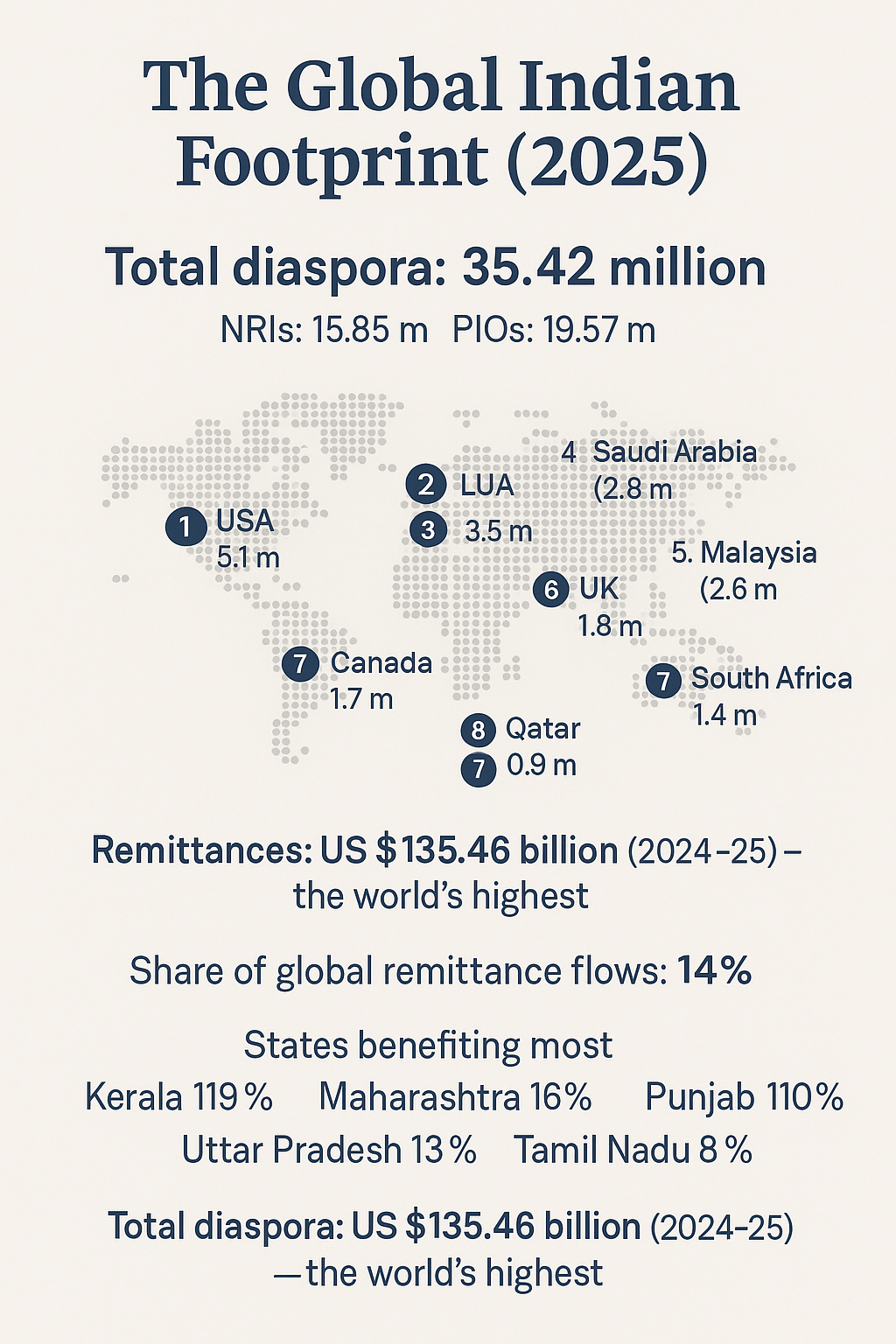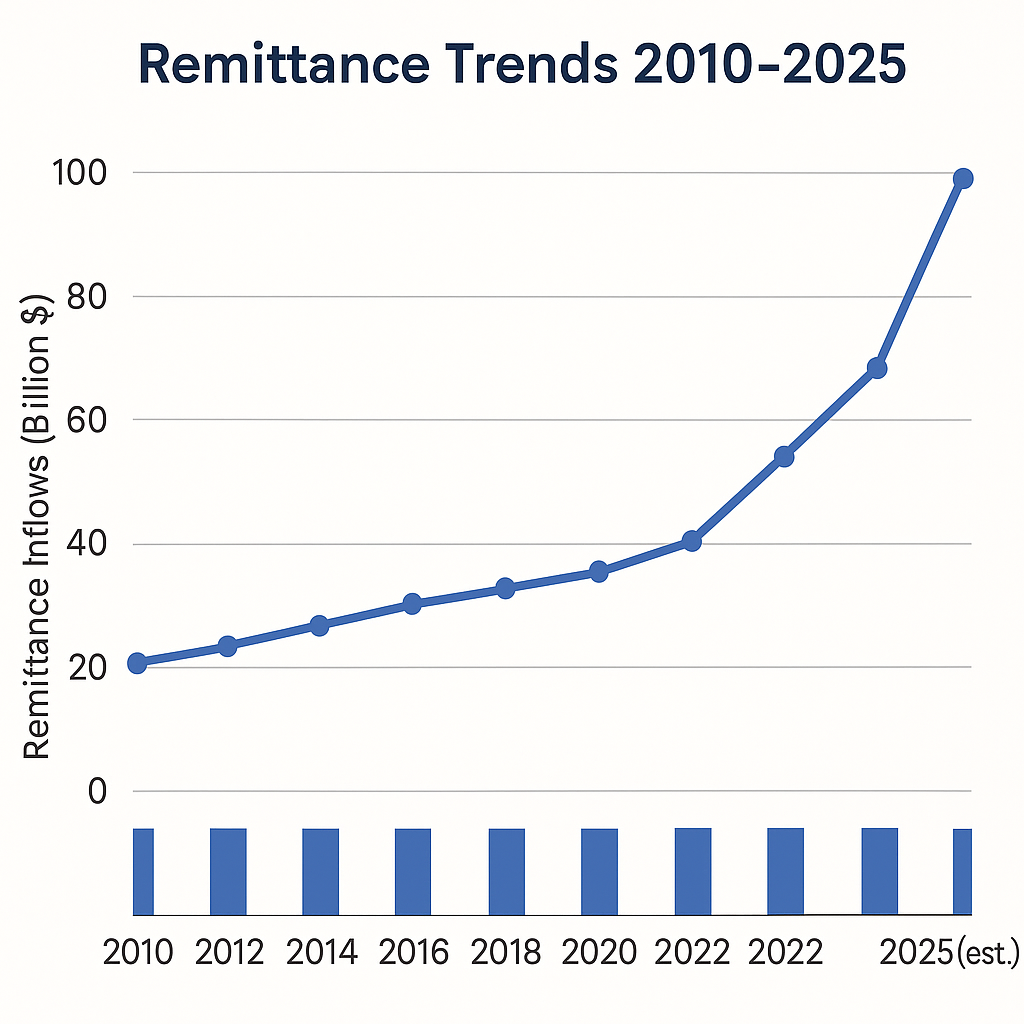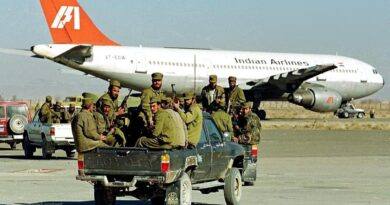New Limits And Heights Of The Indian Diaspora Power
The Diaspora Under Pressure: India’s Global Reach, Soft Power, and the Limits of Influence
The Stakes of Diaspora Diplomacy
In 2025, India’s diaspora is more than an expatriate community, it is a strategic asset, a soft-power network, and a locus of global influence. Official estimates place the Indian diaspora at approximately 35.42 million people as of January 2024, including 15.85 million Non-Resident Indians (NRIs) and 19.57 million Persons of Indian Origin (PIOs). (VIF India) Remittances from this diaspora have remained remarkably resilient; in 2024–25, India received a record US $135.46 billion in remittances, up 14 % year-on-year. (The Economic Times) These flows alone make India the world’s largest recipient of remittances, underscoring the fiscal and strategic weight of its global community.
Yet beneath these figures lies a contested terrain. Diaspora populations face tightening immigration rules, political pressure, and ideological expectations from both their host states and the Indian government. In recent years, Indian authorities have increasingly sought to influence or manage diaspora voices, not merely through cultural diplomacy, but through legal, bureaucratic, and even coercive means. (Al Jazeera) This intensifies a paradox: while diaspora soft power gives India reach, overreach may generate backlash, alienation, and reputational costs.
This article examines three dimensions of this tension:
- The evolving strategic value India places on its diaspora and how that shapes its foreign policy.
- The pressures and constraints diaspora individuals now face, through visa, immigration, or political controls.
- The limits and risks of influence, and what a sustainable diaspora diplomacy must look like.

Diaspora as Strategy: Soft Power, Lobbying & Bridge Building
For decades, diaspora engagement has been a staple of India’s foreign policy. Since 2014, New Delhi has actively cultivated overseas Indians as “ambassadors of Indian values,” urging them to serve as bridges between host countries and the homeland. (Daily Excelsior) The logic is clear: diaspora communities often understand both the host nation’s political culture and the Indian identity. They can influence foreign-policy discourse, investment flows, and public perception.
In the Gulf region, where millions of Indian emigrants reside and send back significant remittances, diaspora presence has been integral in forging bilateral ties. The Indian diaspora in Saudi Arabia, for instance, plays a critical role in sustaining labour diplomacy, energy cooperation, and cultural linkages. (SAGE Journals) In Europe and North America, Indian communities actively lobby for bilateral trade, investment, and defence agreements.
Remittances themselves offer soft leverage: they engender goodwill among host country elites and reduce diaspora resistance to policy expectations. Beyond money, diaspora organisations sponsor cultural festivals, fund schools and temples, and sponsor think tanks, creating an informal network of influence. The 2025 Aravalli Summit at JNU, themed “India and the World Order: Preparing for 2047,” includes a focus on diaspora and migration in its agenda, signalling how diaspora is integrated into India’s long-term global strategy. (The Times of India)
But strategy also has a cost. The expectations placed on diaspora to toe the line in home-country politics blurs the boundary between soft power and political policing.
The New Pressures: Immigration Control, Surveillance, and Soft Coercion
In recent years, India has begun deploying new levers to monitor, influence, and control diaspora voices. One significant method is the selective use of immigration and citizenship tools. A 2025 Al Jazeera report described how Indian authorities weaponise immigration control to silence critical journalists abroad. Under the Overseas Citizenship of India (OCI) scheme, for instance, there is concern among diaspora that status may be threatened for speech that contradicts official narratives. (Al Jazeera)

In the United Kingdom, 54 % of British Indians surveyed by the Platform for Indian Democracy expressed concern about India’s political direction, indicative of growing unease among diaspora communities about interference and backlash. (Al Jazeera)
Another flashpoint is the tightening of U.S. visa regimes. In early 2025, the new Trump administration introduced stricter H-1B visa rules, affecting a visa programme on which many Indian tech professionals depend. (The Diplomat) Because Indian nationals traditionally receive the majority share of H-1B grants, these changes carry outsized impact on Indian diaspora professionals.
The dramatic example of repatriation flights in February 2025 further strained ties: 104 Indian nationals were deported in handcuffed conditions on a U.S. military plane, landing in Amritsar, a move widely criticized in India and among diaspora communities. (Wikipedia) Hundreds of thousands more Indians have reportedly been flagged for deportation, fuelling fear and insecurity.
The United States also repatriated about 100 Indian nationals who had crossed the border illegally; when a U.S. military plane landed in Amritsar for this purpose in February 2025, it symbolised how immigration has become a friction point in bilateral relations. (Niskanen Center)
These pressures lead to chilling effects. Diaspora individuals with dual loyalties or ideological views critical of New Delhi may limit their public statements, self-censor, or disengage from community networks.
The Diplomatic Backlash: When Influence Becomes Strain
These interventions do not always succeed. Diaspora populations are not passive instruments; they carry their own identities and political heritages shaped by their host societies. Heavy-handed control sometimes backfires, lowering trust and reducing influence.
In the U.S., many Indian Americans are civic actors in their own right. Attempts at “transnational loyalty” demands, from urging diaspora to campaign for Indian positions or forego criticism, can clash with their identities as Americans. Overreach may diminish India’s soft power among these communities.
Trade tensions magnify this strain. In August 2025, the Trump administration imposed an additional 25 % tariff on Indian goods, citing India’s oil ties with Russia, bringing total duties on some goods close to 50 %. (Reuters) In response, India accused the U.S. of unfair practices. Many diaspora businesses in the U.S. and Canada found themselves stuck between loyalty to homeland and survival in local markets. Some were forced to adjust supply chains or suffer losses.
This tariff war also threatened the Quad summit, which was expected in late 2025, but is now unlikely, in part because of trade tensions between India, the U.S., and Japan. (Hindustan Times) The very multilateral frameworks India champions are thus vulnerable to bilateral frictions.
Meanwhile, diplomatic ties fray. Analysts have described India–U.S. relations in 2025 as reaching their lowest point since the late 1990s, citing the personal mistrust between President Trump and Prime Minister Modi. (The New Yorker) Shared strategic interests remain, but personal rapport has cooled. (TIME) As the relationship becomes more transactional, diaspora channels for soft diplomacy risk being downgraded.
Still, both sides recognise interdependence: in early 2025, India and the U.S. initiated discussions on trade renewal, investment frameworks, and defence ties, signalling that diplomacy is quietly being patched up. (TIME) Yet the underlying trust deficit and tariff shadow may complicate diaspora engagement.
Identity, Fragmentation, and Generational Shifts
The Indian diaspora is not monolithic. It comprises high-skilled professionals in North America and Europe, contract labour in the Gulf, older settlers in East Africa, and everything in between. (Compass by Rau’s IAS) Each group carries different expectations and pressures.
Skilled Indian professionals in the U.S., U.K., and Canada tend to prioritise immigration stability, professional rights, and global citizenship identity. For many, their Indian heritage becomes an optional identity, layered over national belonging in their host country. The tightening of visa rules or threats to OCI status can provoke strong reactions.
In contrast, Indian workers in the Gulf, especially low- and middle-skilled migrants, face more immediate survival pressures: wage disputes, legal protections, remittance security, and even deportation risk. India’s foreign missions are often criticised for inadequate support to distressed diaspora, particularly during crises. (PWOnlyIAS)
Generational change complicates this further. Second- and third-generation diaspora Indians often feel more loyal to their country of birth while still seeking cultural connection to India. Language attrition, lack of direct diaspora policy relevance, and host-country integration dilute influence.
A 2025 analysis noted that many diaspora Indians struggle to retain Indian language, cultural traditions, and familial expectations around arranged marriages or heritage. (theunitedindian.com)
As they assimilate, demands change, from access to Indian voting mechanisms to bilateral taxation treaties, rather than political loyalty to Indian policy agendas.
India’s strengths lie in diaspora unity around identity, culture, and economic collaboration, but misjudging generational drift risks alienating future cohorts.
Risks of Overreach: Alienation, Reputation, and Retaliation
When China or other nations attempt diaspora influence, their efforts often breed suspicion among host countries. India must tread carefully to avoid similar reputational risk.
Overzealous monitoring of diaspora media, influence campaigns, or legal pressure on critics can provoke backlash in democratic nations. If diaspora Indians perceive the Indian state as intrusive or punitive, loyalty may erode rather than strengthen.
Moreover, diaspora activism may conflict with host country politics. In democracies, when diaspora groups advocate Indian government positions overseas (e.g., Kashmir, foreign policy), they sometimes face local backlash or accusations of lobbying as foreign agents. This raises legal and political risk, especially where local laws regulate foreign influence or political advocacy.
Another danger is “soft suppression” through immigration leverage. If Indian government threats to OCI status or support services become credible, diaspora voices may self-censor. But those who value free speech may regard this as oppressive, with reputational consequences for India among global liberal audiences.
Finally, diaspora support is not unlimited. If India’s domestic politics remain polarised or rights under pressure, diaspora may distance themselves. Asset flight, reduced investment, and political distancing are real risks.
Reimagining Sustainable Diaspora Diplomacy
Given these tensions, what might a more resilient, inclusive, and trustworthy diaspora strategy look like? Below are several principles and policy suggestions.
1. Respect Autonomy, Not Loyalty Demands
India should recognise diaspora as independent actors, not emissaries. While the state may have interests, it must not view every diaspora Indian as a political arm. Support cultural, economic, or educational linkage, not ideological conformity.
2. Protect Diaspora Rights, Especially Freedom of Expression
Rather than penalising critical voices, the Indian state must offer clear protections and appeal processes. Suspending OCI passes for speech must be replaced with transparent legal standards and recourse. This fosters credibility and trust.
3. Strengthen Support Institutions
Indian foreign missions must scale their consular reach, legal aid, emergency services, and diaspora liaison functions. This is especially vital in countries where diaspora are vulnerable, Gulf States, for instance.
4. Segmented, Context-Sensitive Policies
Avoid one-size-fits-all diaspora policy. Gulf workers, European professionals, and African settlers have distinct needs. Tailor services, welfare, investment channels, return migration support, accordingly.
5. Engage Generations & Celebrate Plural Identities
Create forums and platforms that allow diaspora youth to engage with India on relevant issues: climate tech, start-ups, public health, and culture. Recognise that their primary identity may be cosmopolitan or hybrid, and that’s not a threat.
6. Promote Institutional Checks and Accountability
Diaspora programmes (like Pravasi Bharatiya Divas) must be insulated from partisan politics. Institutional checks can prevent the misuse of diaspora platforms for electoral or polarising agendas.
7. Strategic Restraint in Diplomatic Turf
Avoid overt diaspora lobbying where it collides with host country sovereignty. For bilateral tensions, emphasise dialogue and normal diplomacy, not diaspora pressure campaigns.

Case Study: U.S.–India Relations and Diaspora (2025)
The 2025 diplomatic and trade crisis between India and the United States provides a telling microcosm of diaspora tensions. In August, the Trump administration levied additional 25 % tariffs on Indian goods, bringing some tariffs up to 50 %,a move India described as “unjustified and unreasonable.” (Reuters) Some Indian exports to the U.S. fell sharply; Delhi considered WTO retaliation. (Eurasia Review)
Simultaneously, diaspora-owned businesses faced trade headwinds in American supply chains. Indian Americans were caught between loyalty to India and survival in the U.S. market.
This flare-up followed a deteriorated trust relationship: analysts now regard U.S.–India relations as at their lowest ebb since the late 1990s. (The New Yorker) Even as both governments seek to patch ties, the tariff shadow undermines diaspora’s intermediary role.
In early 2025, Prime Minister Modi visited the U.S. (12–15 February) and met with President Trump. They launched Mission 500, a goal to raise bilateral trade to US $500 billion by 2030, and proposed a ten-year defence cooperation agreement. (Wikipedia) Yet these symbolic gestures contrast with strained trust and aggressive tariff politics.
At the same time, the U.S. deported 104 Indians via military aircraft in February, sparking outrage in India and diaspora communities. (Wikipedia) That incident symbolises how immigration and trade politics overlap, reinforcing that diaspora are vulnerable to both foreign policy winds and domestic pressure.
The cumulative effect: diaspora influence is being squeezed between economic pressure, visa instability, and narrative policing.
The Way Forward: A Balanced Diaspora Strategy for 2047
As India marches toward its centenary in 2047, the diaspora’s role will remain central, but only if managed with humility, respect, and realism.
- Diaspora influence does not scale through coercion but through consent.
- Soft power cannot survive if sacrificed at the altar of short-term political gains.
- The diaspora’s loyalty is earned, not commanded.
- India must cultivate diaspora trust through consistent legal protections and open dialogue.
- Host countries, too, must be partners, not battlegrounds.
If managed wisely, the Indian diaspora can remain one of India’s strongest bridges to global legitimacy. But if exploited tactically, it may fracture the very bonds that gave it strength.




